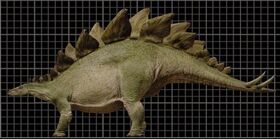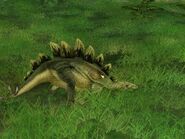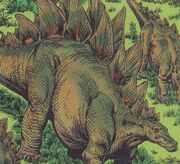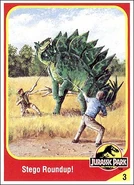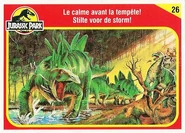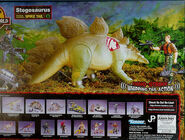mNo edit summary |
mNo edit summary |
||
| Line 77: | Line 77: | ||
Tumblr_lkqn34jURl1qhsdu1o1_1280.jpg|Artwork (source unknown) |
Tumblr_lkqn34jURl1qhsdu1o1_1280.jpg|Artwork (source unknown) |
||
Stegosaurus.jpg|Fan art by ''Hellraptor'' |
Stegosaurus.jpg|Fan art by ''Hellraptor'' |
||
| − | Stegosaurus Render.png |
||
</gallery> |
</gallery> |
||
==Trivia== |
==Trivia== |
||
Revision as of 22:46, 25 January 2015
Easily one of the best known of all the dinosaurs ever, Stegosaurus is recognized all the world over. It is the biggest and most famous member of the stegosaur family. It roamed the open plains of the Late Jurassic Period in what is now North America. The plates along its back, its small head and spiked tail make it a peculiar and unique dinosaur. This plant-eater evolved to find its food in the low-growing plants of the late Jurassic. The long fearsome spikes on its tail would have made a powerful weapon against any hungry predators.
Stegosaurus is often called the dumbest dinosaur because of its incredibly small brain. In fact, most scientists believe that its brain was too small to control such a large creature and that it used an auxiliary "brain" located above its rear legs to help control its movements. This was not actually a brain, but a bundle of nerves that helped relay information from its real brain. Its brain was once thought to have been the size of a walnut, but CAT-scans proved that it was actually the size of a kitten.
Most fascinating to people are the plates along its back. There has been a great deal of debate about their use and arrangement. The plates were up to 2-feet tall and 2-feet wide (.6 m). The most prevalent theory is that they were used for cooling or heating the animal. A more recent theory, however, suggests that they could have been used as a display during courtship and that they may have been brightly colored. It is also possible that they could move up and down, perhaps to intimidate predators.
The spikes on its tail are also the subjects of some controversy. For years, every model of Stegosaurus showed it with the spikes sticking up into the air. It is only since the 1990s that it has become accepted that these spikes stuck out horizontal to the ground, which would have been a potent defensive weapon when swung at a hunter.[1]
Stegosaurus would have lived in family groups and herds, moving slowly through forests while eating the low-growing plants. Its front legs were considerably shorter than its hind legs, making it adapted to nibbling the plants closest to the ground. Stegosaurus is the namesake for a large family of dinosaurs whose members were found all over the world. The Stegosaurus (its code name "Stego") was a peaceful herbivore, and probably roamed the prehistoric highlands in herds that size from small to large numbers, grazing on low ground plants. An average Stegosaurus was about the size of an elephant, standing about 11 feet tall. It had a very low intelligence (its brain was the size of a kitten). The bony plates on its back may have served a dual purpose of a body temperature regulation and protection from large flesh-eating predators. Different species had different numbers of tail spikes. For example, Stegosaurus stenops had 4 spikes, Stegosaurus ungulatis had 8 spikes.[2]Different species also varied in the number of plates on their backs.
| Wikipedia has a more detailed and comprehensive article on Stegosaurus |
Story
Creation
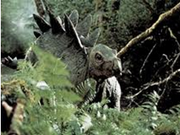
Claire the baby Stegosaurus
Stegosaurus was successfully recreated by InGen in the lab on Isla Sorna. The Stegosaurs were parented and fed in captivity on the island. Stegosaurus is green in color with brown plates exhibiting a paler center. InGen's Stegosaurus appears to be 12 meters long, which is much larger than Stegosaurus armatus, the largest known Stegosaur with a length of 9 meters. InGen may have increased its size to make it more spectacular.
For unknown reasons, it was not planned to appear in Jurassic Park.[3]
Living in the wild
When Hurricane Clarissa struck Isla Sorna, the InGen personnel left the island. The Stegosaurs were either set free by the workers, broke out on their own or because the storm had damaged fences. Stegosaurus roamed freely across the island. Massive animals, they were some of the largest of the animals on the island.
The Stegosaurs had to learn to live in the wild. Since they no longer received lysine supplements in their food, they started to eat lysine rich plants. It is unknown how many Stegosaurs lived on the island. The few humans that visited the island since the hurricane had some encounters with Stegosaurus.
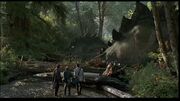
Gatherers watch stegosaurs on the River bank.
During the events of The Lost World: Jurassic Park (1997), the Gatherers encountered a small Stegosaurus herd near a river bed; a pair bond, a subadult. and an infant.
Sarah Harding approached the herd very closely. She encounters an infant stegosaur, Claire, and she takes pictures of her. When the film of her camera was full it started to make noises. Because of the noise the herd sees Sarah as a threat to their young and start to attack Sarah.
Later, Peter Ludlow's hunters captured both an infant and an adult Stegosaurus. It is unknown if the baby Stegosaurus is Claire or an entirely different infant. They appear again near the end of the film migrating across the island.
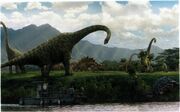
Stegosaurs by the river.
In Jurassic Park III, Stegosaurs were also briefly encountered near another river where Dr. Alan Grant and the Kirby family road a boat through. Stegosaurs lined the river sides.
Jurassic World

Masrani Global Corporation created a new dinosaur zoo on Isla Nublar: Jurassic World. These new clones had a dark tan skin with light olive green. A group of Stegosaurus lives in the Gallimimus Valley and can be seen in the Cretaceous Cruise attraction.
Gallery
Videos
Images
Trivia
- The name "Stegasaurus" (A typo, obviously,) was seen next to a vial in the Cold Storage Room, when Dennis Nedry stole some embryos.
- An illustration of its skull appears in Jurassic Park: The Game.
Jurassic Park novel
InGen created a herd of four stegosaurs in a territory of Isla Nublar called Stegosaur South. This territory was probably located at the southern tip of the island, in the more volcanic region.
It is shown in the chapter "The Tour" that more stegosaurs, as well as more Triceratops and a new dinosaur called "Coelurosaurus", were going to be hatched for the park from eggs in the hatchery.
The creature is encountered in the chapter "Stegosaurus". Donald Gennaro's inspection team arrives at the location after they had seen the Saurapod Swamp. The team leaves the Land cruisers to inspect a sick stegosaur. The creature is described as: "twenty feet long, with a huge bulky body and vertical armor plates along its back. The tail had dangerous-looking 3 foot spikes. But the neck tapered to an absurdly small head with a stupid gaze, like a very dumb horse".[4] The animal smells and pants for breath, because the current atmosphere has a lower oxygen level (21%) than in Mesozoic times (27%). Alan Grant finds raptor egg fragments within the Stego's range.
Gerry Harding tells the team that the stegosaurs make a fixed route through their territory which takes a week. One in six weeks the animals get blisters. The team discovers later that the animals get sick because once in 6 weeks the animals swallow stones which they use as gastroliths, while they do this they also swallow the berries of the poisonous Melia azedarach.
Dennis Nedry stole a Stegosaurus embryo from the Cryo Labs.
When Tim Murphy climbs out of the tree (after the T. rex attack) a Stegosaurus is walking by. The creature behaves/moves like a large tortoise. He describes it as being stupid, and he easily scares it off by throwing a rock.[5]
By the end of the novel, only 1 remains and is seen on one of the monitors fighting with the young Tyrannosaurus rex. The animal was likely killed in the Napalm Bombing.
The Lost World novel

Sarah meets the Stegosaurus. Fanart by Z-Z-Boomslang[6]
Stegosaurus is first seen by the Site B river with the other dinosaur herds. There is a single, solitary stegosaur that is seen by the river and it is quite possibly the only Stegosaurus that is seen in the entire novel.
After Sarah Harding regained consciousness after pulling herself up onto the shore of Site B, she discovered that a stegosaur had been licking her face as she was unconscious. The stegosaur's dark-blue tongue was rough like sandpaper and its saliva smelled sweet, like fermenting African beer. She had first mistaken it for a horse, it had dull eyes and soft eyelashes, but then she discovered that the head was too narrow and the snout was too tapered. The Stegosaurus, she described, had a small head, a surprisingly thick neck, a huge and heavy lumbering body, with a double row of pentagonal plates running along the crest of the back and a dragging tail with spikes in it. At first, she thought it was a trick or a hoax. Quickly looking for a seam or mechanical motion, she soon found out it was the real creature. The Stegosaurus' skin had a pebbled texture, not scaly like a reptile's, but more like the skin of a rhino or of a hairless warthog. Like Tim Murphy in the first novel, she found it also had a peaceful, but ignorant. She deduced from her observations that the stegosaur was warm-blooded based on its quick movements and purple tongue.
The Lost World: Jurassic Park video game
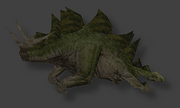
Stegosaurus in PSX The Lost World game. Courtesy of Jurassica.net
Stegosaurus is an enemy in the PSX/Sega Saturn game The Lost World: Jurassic Park. It is encountered in the Tyrannosaurus level.
Trespasser
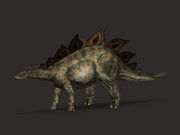
Stegosaurus in Trespasser.
Stegosaurus can be encountered in Jurassic Park: Trespasser. Contrary to what John Hammond says when you see your first Brachiosaurus, a Stegosaurus is a large herbivore from the Jurassic Period. It can be seen in only a few levels, one of which is level 2, the Jungle Road. In this level, the Stegosaur can be used as an alternative for guns for dealing with a nearby Tribe A Velociraptor. Stegosaurs are fairly slow when they move, and their only obvious line of defense are the 3-foot-each spikes on the tail.
Unfortunately, the Stegos in the game don't have any real tail-swipe like in the film, but the spikes can damage the player if one gets too close to them.
Jurassic Park: Operation Genesis
see Stegosaurus/Operation Genesis
Stegosaurus also appears in Jurassic Park: Operation Genesis for PS2, PC, and Xbox, as a four-star attraction. Its fossils are found in the Morrison Formation A (along with Dryosaurus and Ceratosaurus, just like in the real world. It is based on its appearance in Jurassic Park III. Stegosaurus can also have "Death Duels" with Tyrannosaurus rex, usually coming on top by swinging its spikes on to the T. rex's face, thus killing it. Tyrannosaurus will sometimes come on top by grabbing its neck and twisting it hard, very much like the Tyrannosaurus rex and Ankylosaurus death duel. This is possibly a reference to the battle between a Tyrannosaurus and a Stegosaurus in a segment of Walt Disney's Fantasia. It is a friend of Kentrosaurus and moves in herds with them. However, for most of the time, T. rex has a bigger chance in defeating Stegosaurus in Death Duel than Ankylosaurus.
Jurassic Park III: Park Builder
In Jurassic Park III: Park Builder, Stegosaurus is a herbivore that can be created. It is nr. 62 of the Herbivore Threes. A Mini Stegosaurus is also nr. 63 of the Herbivore Ones.
Jurassic Park: Builder

Stegosaurus as seen in Jurassic Park: Builder.
Stegosaurus is one of the available dinosaurs on the IOS application, Jurassic Park: Builder. Though it requires dino-dollers purchase.
Cameos
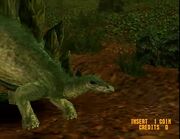
Stegosaurus in the arcade The Lost World: Jurassic Park game
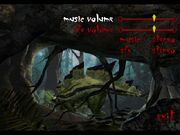
- Stegosaurus is an enemy in the Jurassic Park game for NES. It kills you instantly if you walk into it, but does not attack you.
- The remains of a female Stegosaurus (eaten by Compys) is encountered in the arcade game The Lost World: Jurassic Park, level 1. Some stegosaurs can be seen in the attract mode.
- Stegosaurus appears in the Audio menu of Warpath: Jurassic Park's Options mode. It oddly used Styracosaurus sound. Stegosaurus is not listed in the museum, either.
- Stegosaurus is the 10th dinosaur that appears in Jurassic Park III: The DNA Factor. A swing of its body can create a fierce whirlwind as dangerous as its spiky tail.
- Stegosaurus is one of the animals on Jurassic Park 3 Danger Zone.
Stegosaurus appears as a toy in the Jurassic Park Series 1 this figure inaccurately depicts Stegosaurus and The Lost World Series 1 toy line this version is much more movie accurate.
A Stegosaurus was also going to be made into a figure for the Jurassic Park 2011 toy line featuring a "Dino Damage" skin patch and a whipping tail action similar to The Lost World figure. This figure was later created to be a part of the Jurassic Park 3D toy line, but it too was never released. However, its only appearance is from an image on the back of the toy packages, partially obscured by a blank, yellow sticker.
A small, glass figurine of a Stegosaurus was also released.
A pair of Stegosaurus are seen in the Jurassic Park: River Adventure ride. One of the Stegosaurus appears to be a baby. They reside in Stegosaurus Springs, the ride's equivalent of the novel's Stegosaurus South.
References
- ↑ Stegosaur information at the Dinopedia section of the JPI site
- ↑ Inkworks Jurassic Park III Premium Trading Cards #63.
- ↑ Stegosaurus does not appear in any version of the Jurassic Park brochure, nor in the InGen Field Journal, InGen Field Guide and Tour the Island website.
- ↑ Jurassic Park (novel), page 156
- ↑ Jurassic Park (novel), page 206
- ↑ deviantart.com, picture used with permission.
Template:JPI Dinosaurs
| Compsognathus • Gallimimus • Mamenchisaurus • Pachycephalosaurus • Parasaurolophus • Pteranodon • Stegosaurus • Triceratops • Tyrannosaurus rex • Velociraptor |
| Ankylosaurus • Brachiosaurus • Ceratosaurus • Compsognathus • Corythosaurus • Parasaurolophus • Pteranodon • Spinosaurus • Stegosaurus • Triceratops • Tyrannosaurus rex • Velociraptor |
| Ankylosaurus • Apatosaurus • Dimorphodon • Gallimimus • Indominus rex • Mosasaurus • Pachycephalosaurus • Parasaurolophus • Pteranodon • Stegosaurus • Triceratops • Tyrannosaurus rex • Velociraptor |



